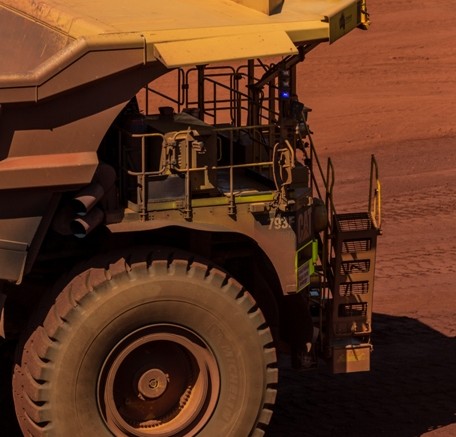Leaders in the mining industry are starting to recognize that automation is part of the answer to the sector’s productivity problems, says Michael Murphy, chief engineer, mining technology enabled solutions with leading mining sector supplier Caterpillar (NYSE: CAT).
“(CEOs are) talking about how there needs to be a step-change in mining, that mining needs to adopt a lot of the capabilities from the manufacturing industry and they view automation as one element — not the only element — but one element they can use to reduce their cash costs,” he said in an interview.
The mining industry is still in the early adoption stage when it comes to automation — a process that has already transformed other industries, such as manufacturing.
A few leading-edge companies, such as Rio Tinto (NYSE: RIO; LSE: RIO), are already deep into implementing automation at some of their operations.
Rio Tinto embraced automation as one component of its “Mine of the Future” program launched in 2008 at its iron ore mines in Western Australia’s Pilbara region.
The mining giant has a large and growing fleet of Komatsu driverless haul trucks at work in the Pilbara, where it also is using autonomous drill rigs developed with Atlas Copco. It’s also about to launch an autonomous heavy haul rail system to serve its operations in the region.
Fortescue Metals Group (ASX: FMG), another iron ore miner in the Pilbara, is also in the midst of incorporating 45 Caterpillar autonomous trucks at its Solomon mine, while BHP Billiton (LSE: BLT; ASX: BHP) is testing Caterpillar trucks at its Jimblebar iron ore mine in the region.
Automation drivers
While there are definitely barriers to adoption, the drivers behind automation are too powerful for the trend to seriously stall.
One of the main goals of automation is to remove humans from the dangerous and monotonous tasks that they’re called upon to do, says Daniel Koffler, senior manager of emerging technology at Rio Tinto.
“The dangerous tasks have inherent danger in them and the monotonous tasks often can build up a danger profile just due to the nature of the work,” Koffler says. “Human capital is best spent outside of the monotonous, repetitive type tasks.”
Flanders, a supplier that says it offers the most advanced autonomous drill system on the market, notes that its fully autonomous system can be used in places where it isn’t safe for people to work.
For example, Rio Tinto used Flanders’ ARDVARC Auto Propel system at its Bingham Canyon open-pit copper mine in Utah following a massive April 2013 landslide, while Newmont Mining (NYSE: NEM) has used the system in Nevada, in areas where there was potential for old underground stopes to collapse.
Another factor, in remote areas in particular, such as the iron ore mines in Western Australia’s Pilbara region, is the challenge of attracting qualified workers and the cost of transporting them to and from site.
“The challenges you have in Western Australia are different to the U.S., or even parts of Latin America,” says Caterpillar’s Murphy. “These mines are one-and-a-half, two hours out of Perth, so you’ve got to fly the workers to the mine at a remote location, and also house and feed them.”
Automation also allows companies to centralize expertise, as Rio Tinto is doing with its remote operations centres in Perth, where the Pilbara mines are monitored and expertise can be shared across sites.
“As the industry matures and becomes more technologically dependent, we’re competing with other industries for brain share and expertise,” explains Rio Tinto’s Koffler. “So what automation also allows us to do is to centralize subject matter experts and make them available to multiple sites globally instead of requiring them to be hands-on at a particular site.”
Productivity and cost are another reason automation is gaining momentum. Humans simply can’t compete with the precision, repeatability, and consistency that machines are capable of.
Productivity also increases with automation because machines don’t need to stop for shift changes, lunch breaks, or for safety reasons during blasting.
Murphy estimates that Caterpillar’s automated haul trucks can provide an extra 500 machine hours per year, which in some cases means 9 or 10% more hours out of the machine.
At its Pilbara operations, Rio Tinto’s recently released some numbers quantifying its return on investment with driverless Komatsu trucks. The company says its automated trucks are 12% more productive than its manned trucks, while the technology has reduced its load and haul costs by 13%.
Automation also decreases the need for training and retraining of new operators when there’s worker turnover. Machines get “smarter” over time, allowing them to continually improve the execution of tasks, Murphy notes.
“I think that’s what people forget about automation: it allows you to measure process and then measure process variants, and then improve the process,” he says. “When you take the person out of it, it’s a lot more controlled.”
In the automated drilling field, Flanders offers four levels of automated drilling systems. Its fully automated Ardvarc Auto Propel system can be fitted onto any make or model of blasthole drill rig, and up to four rigs can be monitored by one technician.
The company estimates the system can extend engine life by 10% just due to the fact that the system can’t operate outside of manufacturer’s specs. With manual drilling, the operator can overextend and damage the drill, shortening its life.
While Kevin Landey, who is responsible for global business development with Flanders, says that drilling costs are about 15-20% lower with autonomous drilling, he notes that blasthole drilling is a small portion of the overall costs at an open-pit mine.
“The importance of this ARDVARC system is not just restricted to the drilling, but it has a huge impact on the whole mining cycle,” Landey says.
In addition to its precision (its guidance system is precise to within about an inch, versus 1 ft. for other, partially automated systems offered by other suppliers), Flanders’ automated system collects real-time data, and provides information about rock hardness — allowing for more efficient use of explosives and better fragmentation.
“Any time you can improve your fragmentation, you’re going to improve your overall recovery and productivity as far as cathode and anode recovery is concerned,” says Jim Elkins, global business development at Flanders. “Fragmentation is just so important to the downstream processing, everything works a lot less — crush, convey, trucks, shovels, when you get great fragmentation. That’s something that every mine strives for.”
The jobs question
Both mining companies and their suppliers say that, contrary to popular belief, automation is not about cutting jobs.
“I think what we’re finding is that we’re shifting the work, and it’s not so much about a head count reduction as it is about applying human expertise to a higher-value type of work,” says Rio Tinto’s Koffler. “We have former truck drivers who are now responsible for and monitoring 10, 15 trucks at a time from a central operations centre. So it’s really a transfer of skill sets more than anything else.”
While that does mean less work for employees who can’t or won’t upgrade their skills, Koffler notes that every industrial advancement has historically brought up the same concern.
“There was the same argument when the
steam shovel was first introduced, but I don’t think anybody would advocate going back to a pick-axe just to maintain employment levels,” he says. “Again, there’s a balance there.”
Koffler adds that mining companies have no desire to replace their whole workforce.
“We’re going after the efficiencies that we can gain and again, the reduction in injury rates and things like that are really as important to us as anything else.”
While there is to some extent creation of higher-skill jobs with automation, overall jobs are still reduced. That’s one of the big barriers to companies adopting Flanders automated drill system, especially in countries such as South Africa where jobs are a sensitive issue, says Flanders’ Landey.
“When you go autonomous, one drill operator can command up to four drill rigs, so that’s three jobs in the sector lost,” Landey says. “I think for the mining houses and the mines themselves, if they were forward thinking enough, they would be taking the operators and converting operators into qualified technicians because you do need a lot of support for all this technology.”
Expense is another barrier to adopting new technology in the current cost-cutting environment.
Outside of the really big mining houses, which have the resources to invest and have crafted strategies on how to increase productivity, most companies are just trying to keep their heads above water.
“They’re just trying to maintain production and maintain headcount,” Flanders’ Elkins says. “So spending on technology right now — you’ve really got to work hard to justify it.”
Part of the reason the mining sector isn’t more advanced in its adoption of new technology is the need to squeeze as much use as possible out of existing assets, which tend to be capital intensive, says Daniel Koffler, Rio Tinto’s senior manager of emerging technology.
“The pace is slower because we try to extend the life of our assets that much longer,” Koffler notes. “It’s not like a consumer who can lease a car for a couple of years and then trade it in for a new model. We really try to maximize the revenue out of every piece of equipment.”
Even at Rio Tinto, a company that prioritizes innovation and is known as an early adopter of technology, Koffler says only about 20% of the company’s technology is leading edge, with the vast majority being classified as legacy technology.
Conservative industry
It’s often said that mining is a conservative industry, and suppliers say they do encounter resistance to new technology they’re offering just because it’s unfamiliar.
However, companies are also trying to be prudent in the face of so many unknowns.
“If you want to automate technology successfully, you’ve got to have the right processes in place, the right commitment through all layers of the organization, so a lot of mining companies are waiting and seeing, ‘OK, is the technology really going to deliver? Do we have the capabilities to support it within our organization? Can we make those changes?’” says Caterpillar’s Murphy.
“The barriers are coming down as mining companies start to see the value, start to see what their peers are doing.”
In some ways, it may be smart to wait — not because all the wrinkles will be smoothed out by other companies, but because there are always unexpected issues that come with new applying new technology.
For example, Rio Tinto found it had to introduce some randomness into the algorithms that guide its automated trucks in the Pilbara. The trucks were so precise in their navigation and had been following the same path so exactly that they were wearing grooves in the service roads.
There can also be hidden costs, said Rio Tinto’s Koffler at the inaugural Technology and Innovation in Mining conference in Toronto in September.
“Implementing the same technology in a different environment can often lead to a whole different set of unexpected costs or challenges that need to be addressed. So don’t think you’re immune from the hidden costs or real TCO (total cost of ownership) just by being the second wave in implementing a technology.”
Koffler added that as the industry becomes more technologically dependent, the complexity of the systems operations rely on will increase — and so will the risk of cascading effects when there’s a failure.
“Now when a system goes down, it’s not an individual piece of equipment that might end up idling through a shift, it could be 14 trucks that are sitting idle because someone accidentally rebooted a core switch or router,” he explained.
But as more companies start to adopt automated technology, and the benefits of automation are becoming clearer, Murphy sees signs that the industry is starting to warm up to automation.
For example, demand for automated drilling — a space that Caterpillar is working on entering with a new product launching shortly — is increasing in Africa, Australia, the U.S., Canada and Latin America, Murphy says.
“The adoption rate is increasing quite significantly and it’s driven by the economics of mining.”
— This article originally appeared in the November 2015 issue of Mining Trends & Developments




Be the first to comment on "Adventures in automation"